- Update December 2020
- I've moved the previous update notifications to the bottom of this post to get them out of the way.
In 2016, the winter solstice will fall on the 21st December. The moment of the solstice1 will be 10:43am in Dublin. The sun will rise in the morning at 8:38:24, and it will set in the afternoon at 16:08:08. This will give us 7 hours, 29 minutes and 44 seconds of daylight. As there will be 7 hours, 29 minutes and 48 seconds daylight on the 20th December, and 7 hours, 29 minutes and 47 seconds on the 22nd, we can be sure that the shortest day of the year is the day of the winter solstice, which will be the 21st December this year.
OK. You've made your point. Haven't you?
Actually, no. And this is the good news for those who are looking forward to the evenings to get longer:
The day on which the sun will set earliest in Dublin in 2016 will be the 13th of December (at 16:06:08), and the evenings will begin to get longer on the 14th, when the sun sets at 16:06:10, two seconds later.
Yup. The grand auld sthretch this year will begin in Dublin on the 14th December. In fact, you can put December 14th into your calendar for every year as the day the grand auld sthretch starts in Dublin.
Explanation 1
When I launched the Grand Auld Sthretch Twitter account last year, I had a suspicion that something wasn't right with the story that the earliest sunset was on the same day as the winter solstice. Those who follow me on Google+, Social Gibiris or Twitter may recognise this:
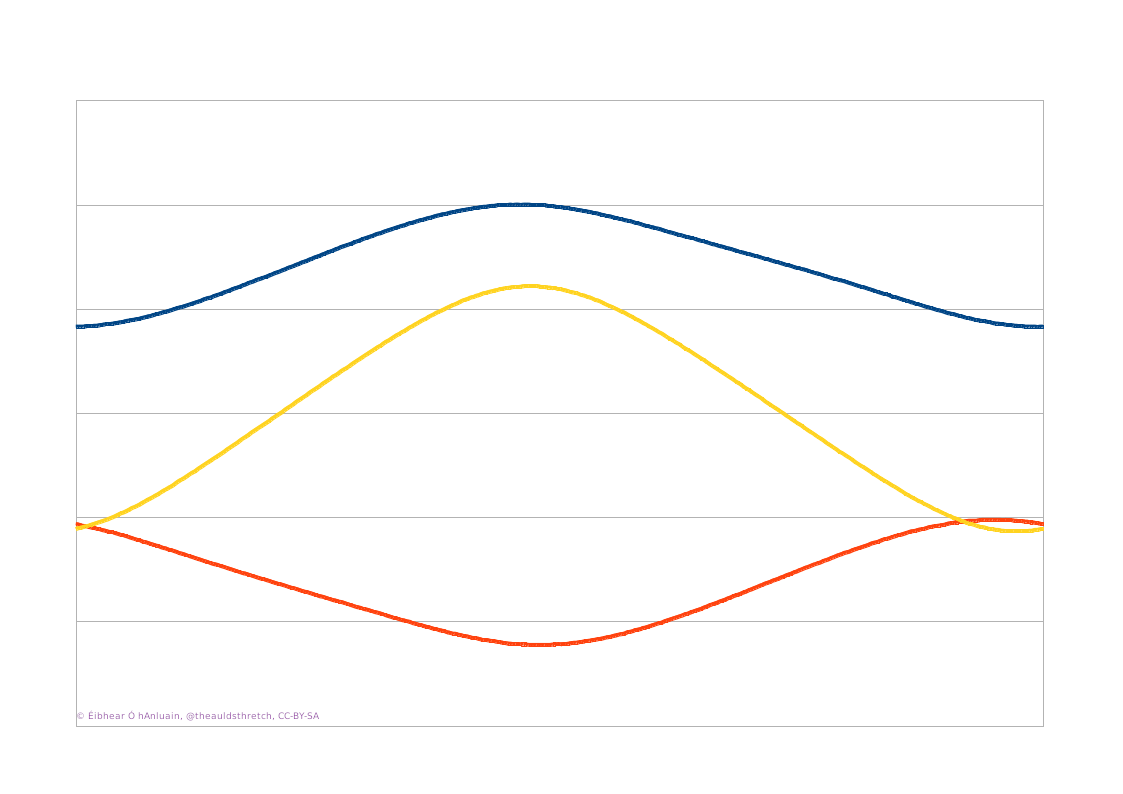
I often use this as a social media avatar2.
It's a representation of the sunrises (blue line), sunsets (red) and amount of daylight (ehhm, yellow) throughout 2012. The x-axis are the days of 2012. The y-axis on the left has 00:00:01 at the top, and 23:59:59 at the bottom. The blue and red lines are associated with that one. The right-hand y-axis is the reverse of the left – with 00:00:01 at the bottom and 23:59:59 at the top – and the yellow line tracks it. If you look carefully, you'll see that the highest point of the red line (sunsets) is slightly earlier in the year than the lowest point of the yellow line (the amount of daylight). If the winter solstice is the shortest day of the year (which it is), then you'd think the earliest sunset will be on the same day, but it's not.
I had known about this since I built the graph in late 20113, but I didn't dig deeply into it before I launched @theauldsthretch.
So, a few weeks ago, I did some research.
It's all about the "Solar Noon".
The solar noon is the time of the day that the sun is at its highest point in the sky. It's no coincidence that the time difference between the sunrise and the solar noon is the same as that between the solar noon and the sunset. What is unexpected, though, is that the time of the solar noon is not constant.
Here's that graph again, brought up-to-date for 2017 (and containing a little bit of 2018), with the daylight time removed and with the solar noon added. All three lines are tracking the left-hand axis.
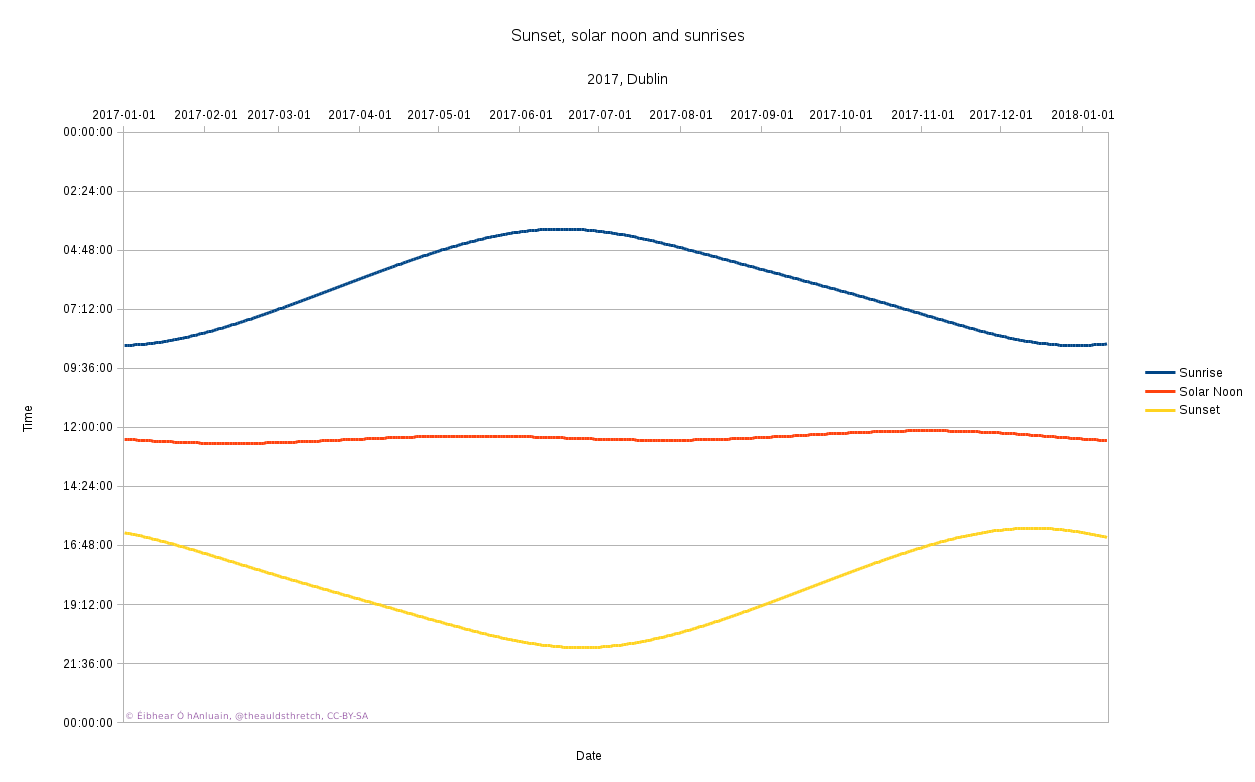
Looking carefully, you'll see that the solar noon wobbles. There's an astronomical reason it wobbles – which I'll get to later – but there's also a social (or "civil") reason. The civil reason is that if we insisted that the time the sun reaches its highest point in the sky was noon on all our watches and clocks, then either (a) the length of the day would not be a constant number of seconds (which it is, at 86,400), or (b) the length of a second would have to change on a daily basis. The solution, however, was to allow the time of the solar noon to change in relation to an otherwise constant civil clock. This is why the solar noon wobbles. Exaggerating the effect, here is how it wobbles:
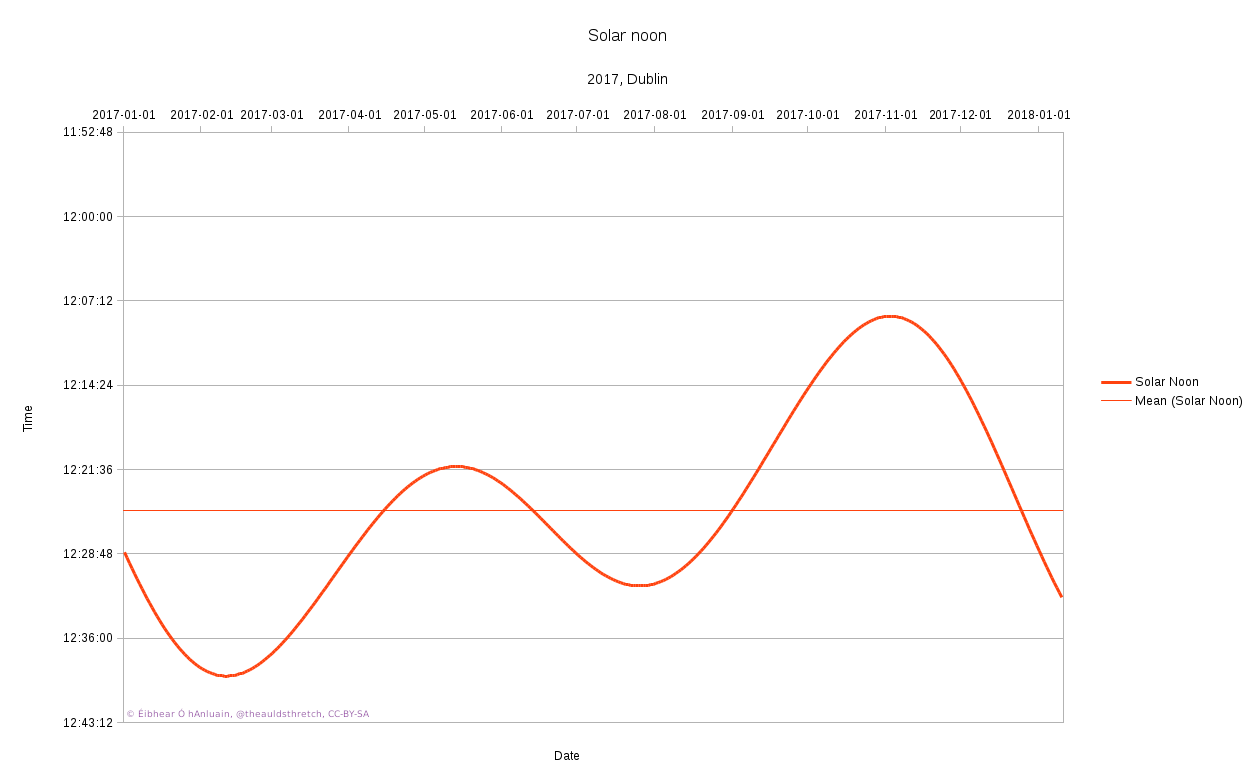
That mean value, as it happens, is 12:25:08.
Looking at this graph, we see that the latest solar noon is in the first half of February (around the 10th), and the earliest solar noon is in early November (around the 3rd).
Imagine the length of the day as constant, for example at 12 hours. The sunrise would be 6 hours before solar noon and sunset 6 hours after. In this case, the sunrise and sunset times throughout the year would be in tune with the solar noon. Like this:
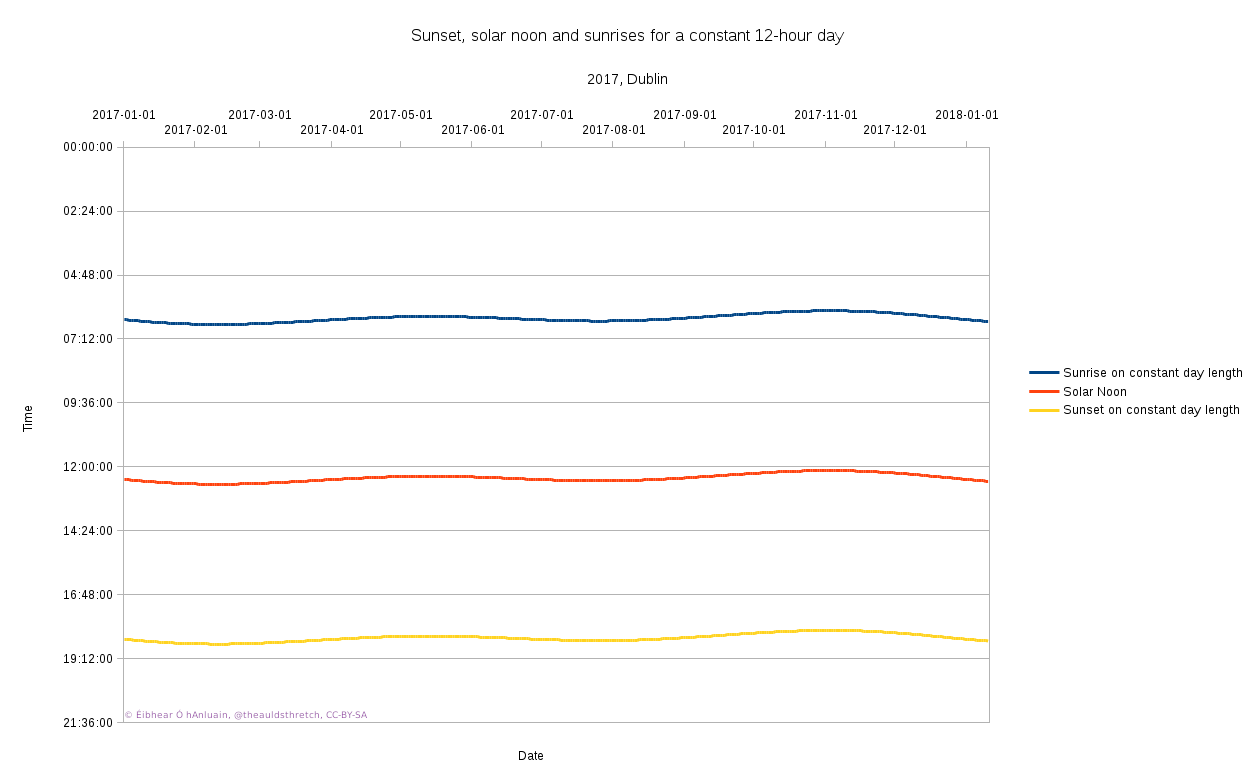
This next graph looks very similar to the first one for 2017 above, but it's not the same. Here is what the sunrises and sunsets would look like if the solar noon was constant (and in this case, we'll set it to 12:25:08, the mean solar noon for Dublin):
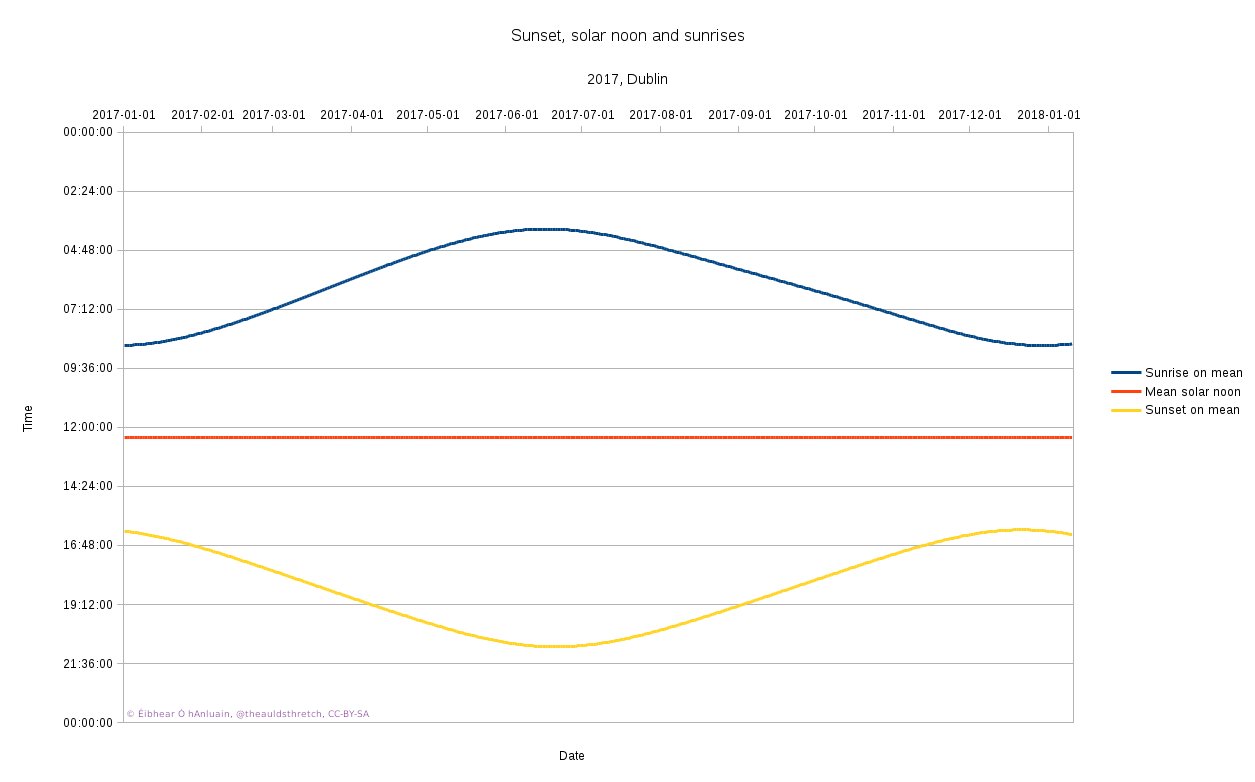
Considering only the sunsets and joining this graph with the previous one we see the following:
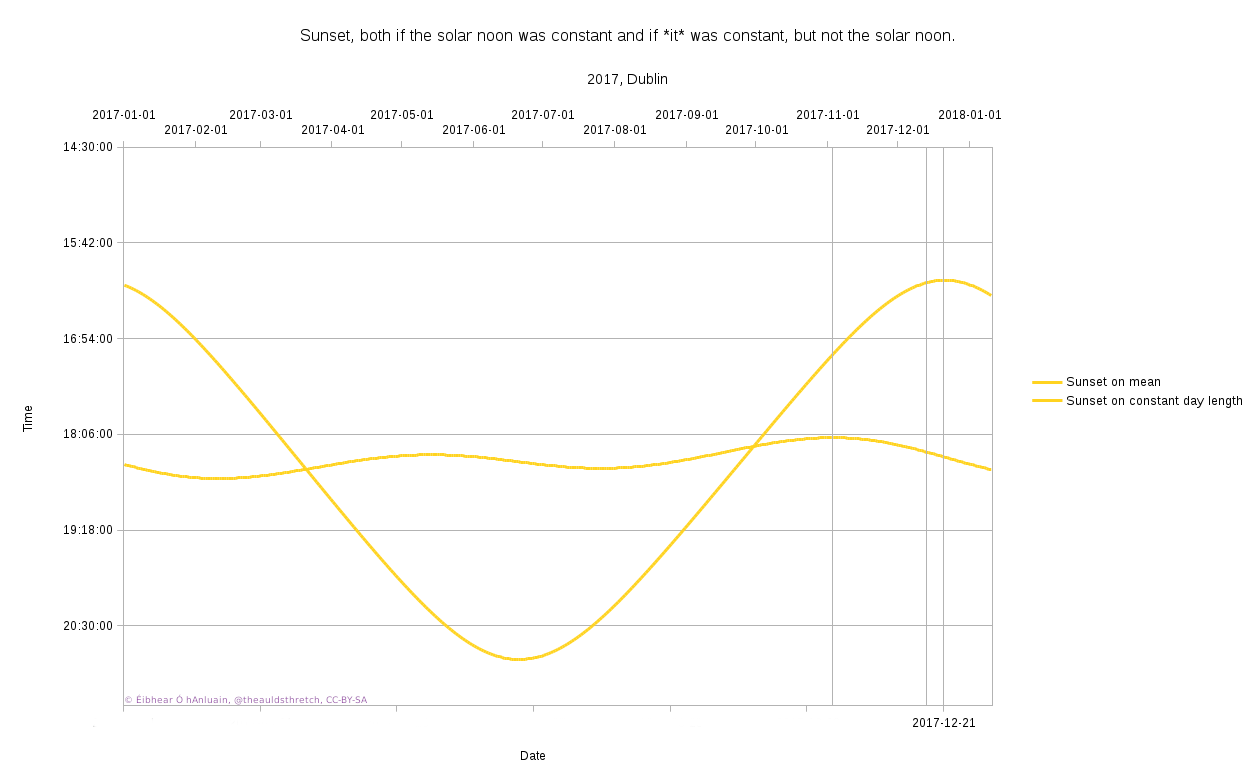
The first date I've marked is the 3rd November, which is when the solar noon is at its earliest time. In our contrived example above, of a constant day length, this is also when the sunset would be earliest. In reality, though, from this day on, the changing solar noon is just putting pressure on the sunset to be later every day.
I've also marked the 21st December, which is when the sunset would be earliest if the solar noon was constant. In reality, as this day approaches, the shortening of the days puts pressure on the sunset to be earlier.
The mark in between the two, the 13th December is when the two pressures meet, and when we get our earliest sunset:
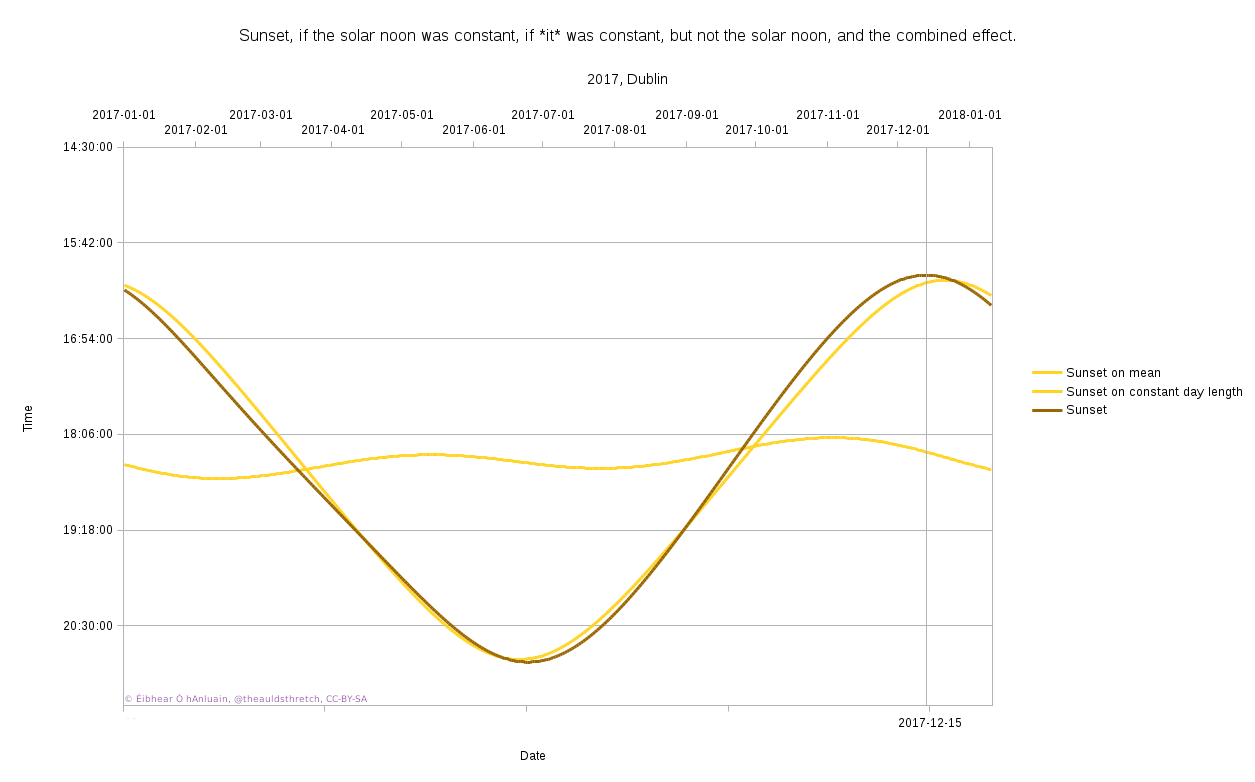
And this is why the earliest sunset is on the 13th of December, and the Grand Auld Sthretch starts on the 14th.
Explanation 2
My explanation above considers the times of sunrises, sunsets and solar noons when presented in graph form. These graphs change when certain (incorrect) assumptions are applied. By demonstrating how these graphs change with these assumptions, I think I have shown why the earliest sunset is not on the winter solstice.
Elsewhere, Larry Denenberg outlines an excellent alternative explanation in his essay Why aren't the earliest sunset and latest sunrise on the same day as the winter solstice?. The approach taken by Larry is to describe 3 phenomena of the earth: that it orbits the sun, that it rotates on its axis and that its axis is tilted compared to the plane of the ecliptic. All three of these phenomena are required to give us this situation.
It's a beautiful explanation, and it took me a number of days to get it out of my head once I fully absorbed it.
- Updates November 2017
I used the phrase "… and the nights will begin to get longer on the …" at the start of this post, which is incorrect, of course. It's more correct to say that they're the evenings that will be getting longer on that day. I have made that correction.
I was mistaken when I said that the earliest sunset will be onthe 13th December every year. It so happens that it's the 13thonly on leap years, and on other years, it's the 14th. This isalso corrected in the post. It continues to confuse me how I gotthat wrong last year: it's the sort of thing I would confirmprior to making such a statement.- Update December 2017
The correction above from November 2017 is totally bogus. At this point in time, I don't know how, but will look into it when I get a chance.
Anyway, I've reverted the change from before.
- Update December 2018
I've now got to the bottom of it. The version of the software I was using up to January this year put the earliest sunset in Dublin on the 13th December, and the new version I started to use back then has it on the 14th. In December of last year, I was using one version on one computer and the other on the other, hence the confusion.
If you're following my twitter account, you'll see the start of the sthretch being declared for the 15th, so that's how it's going to be!
This is, I promise, the last update to this blog post.
Footnotes:
i.e. the moment at which the sun will be directly over the most southerly latitude that it can be
When the W3C gives up on its reckless and ridiculous effort to allow DRM in HTML5, my Twitter avatar will be reset to the original!
Which I did to prove a point.

You can't add any comments to this post. If there is something you would like to bring to my attention, please use the contact mechanisms below to get in touch.